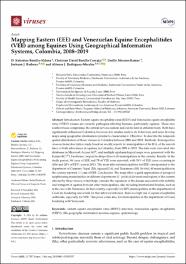Mapping Eastern (EEE) and Venezuelan Equine Encephalitides (VEE) among Equines Using Geographical Information Systems, Colombia, 2008–2019

Ver/
Descargar
(application/pdf: 6.720Mb)
(application/pdf: 6.720Mb)
Fecha
2023-03-08Autor(es)
Bonilla-Aldana, D. Katterine
Bonilla Carvajal, Christian David
Moreno-Ramos, Emilly
Barboza, Joshuan J.
Rodriguez-Morales, Alfonso J.
Metadatos
Mostrar el registro completo del ítemResumen
“Introduction: Eastern equine encephalitis virus (EEEV) and Venezuelan equine encephalitis
virus (VEEV) viruses are zoonotic pathogens affecting humans, particularly equines. These neuroarboviruses compromise the central nervous system and can be fatal in different hosts. Both have
significantly influenced Colombia; however, few studies analyse its behaviour, and none develop
maps using geographic information systems to characterise it. Objective: To describe the temporalspatial distribution of those viruses in Colombia between 2008 and 2019. Methods: Retrospective
cross-sectional descriptive study, based on weekly reports by municipalities of the ICA, of the surveillance of both arboviruses in equines, in Colombia, from 2008 to 2019. The data were converted into
databases in Microsoft Access 365®, and multiple epidemiological maps were generated with the
Kosmo RC1®3.0 software coupled to shape files of all municipalities in the country. Results: In the
study period, 96 cases of EEE and 70 of VEE were reported, with 58% of EEE cases occurring in
2016 and 20% of EEV cases in 2013. The most affected municipalities for EEE corresponded to the
department of Casanare: Yopal (20), Aguazul (16), and Tauramena (10). In total, 40 municipalities in
the country reported ≥1 case of EEE. Conclusions: The maps allow a quick appreciation of groups of
neighbouring municipalities in different departments (1◦ political division) and regions of the country
affected by those viruses, which helps consider the expansion of the disease associated with mobility
and transport of equines between other municipalities, also including international borders, such as
is the case with Venezuela. In that country, especially for EEV, municipalities in the department of
Cesar are bordering and at risk for that arboviral infection. there is a high risk of equine encephalitis
outbreaks, especially for VEE. This poses a risk also, for municipalities in the department of Cesar,
bordering with Venezuela.
“
Colecciones
- Web of Science (WOS) [236]

